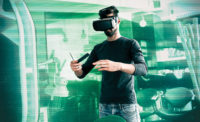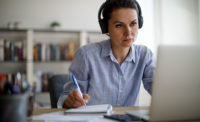Next to the real thing, virtual reality (VR) training is the best way to learn. VR training has been around for many years and in many forms, but generally was limited to people with deep pockets such as the military, NASA and the airline industry with use of flight simulators, for example.
Technological advances, business competition and other changes have created an explosion of VR use by the average consumer. An online search for “VR health and safety training” reveals that this technology is being heavily promoted for use within the OHS profession.
I got the Oculus Go, a stand-alone VR headset, in December 2018 (cost today about $200) and have steadily obtained programs to enhance my learning through purchase of VR programs, with many programs going for under $10 each.
Vodafone’s “Working at height - health and safety experience” and Vector Solutions’ “Smoke Reading in Virtual Reality” were among the first specific OHS VR programs that I obtained. In both examples, these are experiences that I rarely encounter in real-life. If I’m called upon to act in a real-life for either of these events, I now have better awareness and confidence to do the right thing and make correct decisions. I can easily refresh the experience on these topics anytime I feel the need to improve.
Endless choices
Health and safety training is a broad concept. The “Body VR” and BDH’s “Wonderful You” are VR programs I use routinely to further appreciation and enhance my understanding of anatomy and cell physiology. I use VR language programs to further my communication skills within OHS work and elsewhere. VR training programs are expanding to where choices of learning topics may appear endless.
For example, I love to backpack. This year I’ll be at Yosemite with a permit to summit Half-Dome. I’m using various VR programs to go into mountains and manage my mild basophobia, a natural and typical fear of falling experienced by most people.
You must experience VR to appreciate its possibilities. You’ve probably watched a movie on TV of the mountains with someone looking over a cliff edge. Doubtful you experienced any basophobia. Put on a good VR headset with stereo audio, look up, look down, look behind you, step forward, step back, there’s a lot to experience in this 360-degree cliff edge environment – now lean forward and peer over the cliff edge. Mild, and sometimes even extreme, basophobia may be felt. VR tricks your mind to believe it’s almost real. Augmented reality (AR) takes VR to the next level of realism.
Is VR safe?
Learning in a “safe” and controlled environment makes VR possibilities exciting. VR learning is not truly safe, however. My son began beta testing the Oculus Rift with the developer’s kit in 2014. He wouldn’t let me play with the VR system because of severe nausea and visual disturbances that were likely among users of the early programs.
Scholarly articles paint a cautious picture of VR use. Oculus “Health & Safety Warnings” documentation covers nearly a dozen full pages. More H&S information is provided at the Oculus Safety Center at https://support.oculus.com. Be aware that new discoveries of H&S problems and solutions with VR use are likely. Always review the latest scholarly H&S articles.
Summary of warnings
VR systems are not a toy. VR use is not recommended for children under the age of 13. Scholarly articles demonstrating visual disturbances among children triggers this warning.
Wikipedia’s information on VR states that approximately 25-40% of people experience VR sickness, with the most common symptoms being “general discomfort, headache, stomach awareness, nausea, vomiting, pallor, sweating, fatigue, drowsiness, disorientation, and apathy.” Interestingly, symptoms affect women more than men.
Oculus warns that symptoms of VR exposure “can persist and become more apparent hours after use.” People should not drive, not operate machinery, or engage in visually or physically demanding activities with potential for serious injury risk, or other activities that require unimpaired balance and hand-eye coordination until fully recovered from symptoms. Do not use VR headset until all symptoms have completely subsided for several hours, per Oculus.
VR experience requires an “unimpaired sense of motion and balance,” per Oculus warnings. VR headsets should not be used by someone who is tired; needs sleep; under the influence of alcohol or drugs; hung-over; has digestive problems; under emotional stress or anxiety; or when suffering from cold, flu, headaches, migraines, or earaches.
People with pre-existing medical conditions such as pregnancy, binocular vision abnormality, psychiatric disorder, heart condition, history of seizures, or have a medical impact such as cardiac pacemaker, hearing aids and defibrillators should consult with their physician before VR use, per Oculus.
Safe use
A “safe” area in my office is established when I use Oculus Go. I rarely stand or walk when using the system. Most VR use is done sitting in an office chair that swivels 360 degrees and that tilts readily back and forth. This provides enough sense of movement in most VR program environments. The chair’s wheels have five points of contact to limit chance of toppling completely backwards. Chair movement is kept to about a six-foot square that is cleared of any object I may inadvertently contact. To get the best VR experience, I dim lights and put devices on silent mode. VR program use is kept to about 30 minutes or less daily, but this done informally.
Other than learning in hard-to-duplicate actual conditions, scholarly studies show that people absorb information quicker and retain information longer when they learn in VR. The best VR experience requires an engaged mind that treats the VR as real. Truth told:VR learning is fun.




